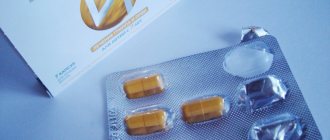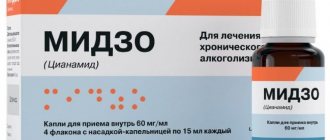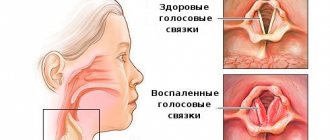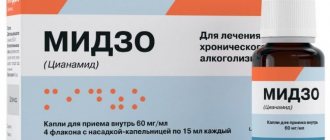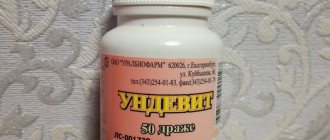Ingavirin is a modern drug with antiviral, immunomodulatory and anti-inflammatory activity. It has successfully proven itself in the prevention of ARVI and influenza, as well as in their treatment. It is distinguished by ease of use and a range of release forms. Registered in Russia and included in the list of vital drugs.
Description of the drug
The main active component is pentanedioic acid imidazolylethanamide (in other words, vitaglutam); the excipients present are colloidal silicon dioxide compound, potato starch and white crystals of magnesium stearate. The capsule shell consists of titanium dioxide, gelatin, azorubine and safe dyes.
Pharmacy chains offer customers:
- Ingavirin capsules with a dosage of 90 mg and 60 mg, which are packaged in blister packs of 10 capsules and in cardboard boxes. This amount is enough for a course of treatment for one person. Inside the capsules there is white or slightly cream-colored powder and granules.
- Syrup containing 30 mg of the main substance in 5 ml. Sold in 90 ml bottles with a measuring syringe and instructions included.
The medicine is intended to activate one's own immunity by enhancing the production of a special protein responsible for the reaction to the invasion of an infectious agent. Suppresses the reproduction of viruses and delays their further advancement in the intercellular space. Due to the production of cytotoxic lymphocytes during the use of Ingavirin, the following occurs:
- Reducing the duration of fever.
- Reducing the symptoms of intoxication - weakness, headache, drowsiness.
- Reducing the inflammatory process.
- Relieving nasal congestion, stopping watery eyes, sore throat and cough.
- Normalization of body temperature.
- Strengthening the immune system.
- Reducing the risk of complications.
Ingavirin has found wide use in therapeutic practice and pediatrics, its effectiveness has been proven in preclinical and clinical studies.
The drug is available from pharmacies without a prescription, has minimal toxicity, combines well with antibiotics and enhances their effect. Stored at temperatures up to 25 °C for two years. An open bottle of syrup should be used within a week.
Ingavirin, 10 pcs., 60 mg, capsules
Antiviral drug. Preclinical and clinical studies have shown the effectiveness of the drug Ingavirin® against influenza viruses type A (A(H 1N1), including “swine” A(I-IlNl)pdm09, A(M3N2), A(H5N1)) and type B, adenovirus, parainfluenza virus, respiratory syncytial virus; in preclinical studies: coronavirus, metapneumovirus, enteroviruses, including Coxsackie virus and riovirus. The drug Ingavirin® promotes accelerated elimination of viruses, reduces the duration of the disease, and reduces the risk of complications. The mechanism of action is realized at the level of infected cells due to the stimulation of innate immune factors suppressed by viral proteins. In experimental studies, in particular, it was shown that the drug Ingavirin® increases the expression of the first type interferon receptor IFNAR on the surface of epithelial and immunocompetent cells. An increase in the density of interferon receptors leads to an increase in the sensitivity of cells to endogenous interferon signals. The process is accompanied by activation (phosphorylation) of the transmitter protein STAT1, which transmits a signal to the cell nucleus to induce antiviral genes. It has been shown that under conditions of infection, the drug stimulates the production of the antiviral effector protein MxA, which inhibits the intracellular transport of ribonucleoproteins of various viruses, slowing down the process of viral replication.
The drug Iigavirin® causes an increase in the level of interferon in the blood to the physiological norm, stimulates and normalizes the reduced α-interferon producing ability of blood leukocytes, and stimulates the γ-interferon producing ability of leukocytes. Causes the generation of cytotoxic lymphocytes and increases the content of NK-T cells, which have high killer activity against virus-infected cells.
The anti-inflammatory effect is due to the suppression of the production of key pro-inflammatory cytokines (tumor necrosis factor (TNF-a), interleukins (IL-1 (3 and IL-6)), a decrease in the activity of myeloperoxidase. Experimental studies have shown that the combined use of the drug Ingavirin® with antibiotics increases the effectiveness of therapy in a model of bacterial sepsis, including that caused by penicillin-resistant strains of staphylococcus. Experimental toxicological studies indicate a low level of toxicity and a high safety profile of the drug. According to the parameters of acute toxicity, the drug Ingavirin® belongs to toxicity class 4 - “Low toxic substances” (When determining LD50 in acute toxicity experiments, lethal doses of the drug could not be determined).
Indications and contraindications for the use of Ingavirin
The drug is prescribed for prophylactic purposes and in the treatment of diseases caused by pathogens of respiratory pathologies.
Main indications:
- Influenza A and B, including swine, parainfluenza.
- ARVI, accompanied by pain in the throat, rhinitis, high fever and cough.
- Adenovirus and rotavirus.
- Enterovirus.
- Rhinovirus.
- Coxsackie virus.
- Syncytial viruses that cause lower respiratory tract infections.
- Coronavirus.
Taking the drug 7-10 days before an outbreak of a viral infection will strengthen the immune system by increasing the level of interferon in the body. The drug will also be effective if use is started after contact with a sick person.
Attention! Treatment with Ingavirin should be started when the initial symptoms of a cold or flu appear - in the first 36 hours.
The medicine is contraindicated in case of individual intolerance to the components included in the composition, as well as:
- During pregnancy and breastfeeding.
- If the absorption of glucose and galactose in the intestine is impaired.
- For lactose deficiency or intolerance.
- Serious pathologies of the kidneys and liver.
- For children under three years of age in any dosage form.
Ingavirin at a dosage of 90 mg is contraindicated for persons under 18 years of age, and 60 mg capsules are contraindicated for children under 7 years of age.
Drinking alcohol reduces its effectiveness. After completing the course of treatment, it is recommended to abstain from alcohol for another 2-3 days.
Ingavirin capsules 60 mg No. 7 for children over 7 years old
A country
Russia
The country of production may vary depending on the batch of goods. Please check with the operator for detailed information when confirming your order.
Active substance
Pentanedioic acid imidazolylethanamide
Compound
Active substance: 2-(imidazol-4-yl)-ethanamide of pentanedioic-1,5 acid - 90 mg.
pharmachologic effect
It has an antiviral effect, effective against influenza viruses type A, type B, adenovirus infection, parainfluenza, respiratory syncytial infection. The antiviral mechanism of action is associated with the suppression of virus reproduction at the nuclear phase, delaying the migration of newly synthesized NP virus from the cytoplasm to the nucleus. It has a modulating effect on the functional activity of the interferon system: it causes an increase in the interferon content in the blood to the physiological norm, stimulates and normalizes the reduced alpha - interferon producing ability of blood leukocytes, stimulates the Y - interferon producing ability of leukocytes. Causes the generation of cytotoxic lymphocytes and increases the content of NK-T cells , which have high killer activity against virus-transformed cells and pronounced antiviral activity. The anti-inflammatory effect is due to the suppression of the production of key pro-inflammatory cytokines (tumor necrosis factor (TNF-a), interleukins (IL-1B and IL-6)), and a decrease in the activity of myeloperoxidase. Therapeutic effectiveness for influenza and other acute respiratory viral infections (ARVI) is manifested in a shortening of the period of fever, a decrease in intoxication (headache, weakness, dizziness), catarrhal phenomena, a decrease in the number of complications and the duration of the disease in general. Experimental toxicological studies indicate a low level toxicity and high safety profile of the drug (LD50 exceeds the therapeutic dose by more than 3000 times). The drug does not have mutagenic, immunotoxic, allergenic or carcinogenic properties, and does not have a local irritant effect. Ingavirin does not affect reproductive function, does not have embryotoxic or teratogenic effects. Pharmacokinetics. Absorption and distribution. At recommended doses, determination of the drug in blood plasma using available methods is not possible. In an experiment using a radioactive label, it was found that the drug quickly enters the blood from the gastrointestinal tract. It is evenly distributed throughout the internal organs. Maximum concentrations in the blood, blood plasma and most organs are reached 30 minutes after administration of the drug. The AUC values (area under the pharmacokinetic concentration-time curve) of the kidneys, liver and lungs are slightly higher than the AUC of blood (43.77 mcg.h/g). AUC values for the spleen, adrenal glands, lymph nodes and thymus are lower than blood AUC. MRT (mean drug retention time) in the blood is 37.2 hours. With a 5-day course of oral administration of the drug once a day, it accumulates in internal organs and tissues. At the same time, the qualitative characteristics of the pharmacokinetic curves after each administration of the drug were identical: a rapid increase in the concentration of the drug after each administration and then a slow decrease by 24 hours. Metabolism. The drug is not metabolized in the body and is excreted unchanged. Excretion. The main elimination process occurs within 24 hours. During this period, 80% of the administered dose is excreted: 34.8% is excreted in the time interval from 0 to 5 hours and 45.2% in the time interval from 5 to 24 hours. Of these, 77% is excreted through the intestines and 23% through the kidneys.
Indications for use
Treatment and prevention of influenza A and B and other acute respiratory viral infections (adenovirus infection, parainfluenza, respiratory syncytial infection).
Mode of application
Inside, regardless of food intake. 90 mg 1 time per day, 5-7 days (depending on the severity of the condition). For the prevention of influenza and acute respiratory viral infections after contact with sick persons: 90 mg 1 time per day, for 7 days. The drug should be taken with the moment the first symptoms of the disease appear, no later than 36 hours from the onset of the disease.
Interaction
No cases of interaction of the drug with other drugs have been identified.
Side effect
Allergic reactions (rare).
Contraindications
Individual intolerance to the components of the drug. Pregnancy. Children under 18 years of age.
Overdose
Cases of drug overdose have not been described.
special instructions
Use during pregnancy and lactation. The use of the drug during pregnancy has not been studied. The use of the drug during lactation has not been studied, therefore, if it is necessary to use the drug during lactation, breastfeeding should be stopped. The drug does not have a sedative effect, does not affect the speed of the psychomotor reaction and can be used in people of various professions, incl. requiring increased attention and coordination of movements. Concomitant use of other antiviral drugs is not recommended.
Instructions for use
Ingavirin is used orally, regardless of food intake.
The prescription depends on the patient’s age, indications and severity of the disease:
- Adults are prescribed capsules at a dosage of 90 mg, 1 piece per day.
- Children 7-18 years old – 60 mg, 1 capsule per day.
- Children 3-6 years old - 30 mg/5 ml syrup once a day.
As a general rule, capsules with medicinal powder cannot be chewed; they must be washed down with a sufficient amount of water. If children of primary school age have difficulty swallowing the capsule, its contents can be dissolved in apple juice or water. It is allowed to add a little sugar to smooth out the unpleasant taste. The prepared solution cannot be stored.
The medicine in the form of syrup can also be used by school-age children and adults, in this case it is prescribed:
- Adults – 15 ml of syrup once a day.
- Children 3-7 years old - 10 ml of syrup.
To draw the required volume of liquid, you need to insert a measuring syringe into the neck of the bottle, turn it upside down and slowly pull the plunger until the medicine is drawn to the desired level. After use, the syringe is washed with warm water and dried.
The duration of treatment for influenza and ARVI is 5-7 days, for preschool children - no more than 5 days. Prophylactic doses and duration of administration are the same as for treatment.
In case of severe symptoms and concomitant diseases of the respiratory system or heart, the doctor may prescribe a double dose of Ingavirin in the first three days of illness, followed by a reduction to the usual dosage for another 2-4 days.
Important! Do not use the drug with other antiviral drugs at the same time.
